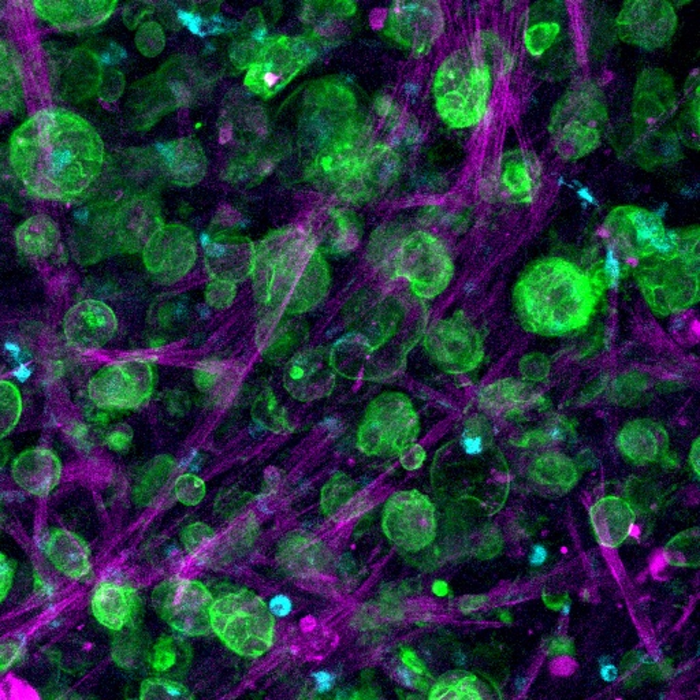An international team of scientists has created a three-dimensional (3D) pancreatic cancer tumor model in the laboratory, combining a bioengineered matrix and patient-derived cells that could potentially be used to develop and test targeted treatments.
In a new study (“Bioengineered 3D models of human pancreatic cancer recapitulate in vivo tumour biology”) in Nature Communications, researchers from the University of Nottingham, Queen Mary University of London, Monash University, and Shanghai Jiao Tong University describe the creation of a multicellular 3D microenvironment that uses patient-derived cells to recreate the way tumor cells grow in pancreatic cancer and respond to chemotherapy drugs.
“Patient-derived in vivo models of human cancer have become a reality, yet their turnaround time is inadequate for clinical applications. Therefore, tailored ex vivo models that faithfully recapitulate in vivo tumour biology are urgently needed. These may especially benefit the management of pancreatic ductal adenocarcinoma (PDAC), where therapy failure has been ascribed to its high cancer stem cell (CSC) content and high density of stromal cells and extracellular matrix (ECM). To date, these features are only partially reproduced ex vivo using organoid and sphere cultures,” write the investigators.
“We have now developed a more comprehensive and highly tuneable ex vivo model of PDAC based on the 3D co-assembly of peptide amphiphiles (PAs) with custom ECM components (PA-ECM). These cultures maintain patient-specific transcriptional profiles and exhibit CSC functionality, including strong in vivo tumourigenicity. User-defined modification of the system enables control over niche-dependent phenotypes such as epithelial-to-mesenchymal transition and matrix deposition. Indeed, proteomic analysis of these cultures reveals improved matrisome recapitulation compared to organoids. Most importantly, patient-specific in vivo drug responses are better reproduced in self-assembled cultures than in other models.
“These findings support the use of tuneable self-assembling platforms in cancer research and pave the way for future precision medicine approaches.”
Disease is difficult to treat
Pancreatic cancer is difficult to treat, particularly as there are no signs or symptoms until the cancer has spread. It can be resistant to treatment and the survival rate is low compared to other cancers, with only a 5–10% survival rate five years after diagnosis.
“There are two main obstacles to treating pancreatic cancer—a very dense matrix of proteins and the presence of highly resistant cancer stem cells (CSCs) that are involved in relapse and metastasis,” said David Osuna de la Peña, a grad student in the lab of Alvaro Mata, PhD, professor in biomedical engineering and biomaterials in the school of pharmacy and the department of chemical and environmental engineering at the University of Nottingham. “In our study, we have engineered a matrix where CSCs can interact with other cell types and together behave more like they do in the body, opening the possibility to test different treatments in a more realistic manner.”
There is a need for improved 3D cancer models to study tumor growth and progression in patients and test responses to new treatments. At present, 90% of successful cancer treatments tested pre-clinically fail in the early phases of clinical trials and less than 5% of oncology drugs are successful in clinical trials.
Pre-clinical tests mostly rely on a combination of two-dimensional (2D) lab grown cell cultures and animal models to predict responses to treatment. However, conventional 2D cell cultures fail to mimic key features of tumor tissues and interspecies differences can result in many successful treatments in animal hosts being ineffective in humans.
Consequently, novel experimental 3D cancer models are needed to better recreate the human tumor microenvironment and incorporate patient-specific differences.
Self-assembly is the process by which biological systems controllably assemble multiple molecules and cells into functional tissues. Harnessing this process, the team created a new hydrogel biomaterial made with multiple, yet specific, proteins found in pancreatic cancer. This mechanism of formation enables incorporation of key cell types to create biological environments that can emulate features of a patient’s tumor.
“Using models of human cancer is becoming more common in developing treatments for the disease, but a major barrier to getting them into clinical applications is the turnaround time. We have engineered a comprehensive and tunable ex vivo model of pancreatic ductal adenocarcinoma (PDAC) by assembling and organizing key matrix components with patient-derived cells,” added Mata. “The models exhibit patient-specific transcriptional profiles, CSC functionality, and strong tumorigenicity; overall providing a more relevant scenario than Organoid and Sphere cultures. Most importantly, drug responses were better reproduced in our self-assembled cultures than in the other models.
“We believe this model moves closer to the vision of being able to take patient tumor cells in hospital, incorporate them into our model, find the optimum cocktail of treatments for a particular cancer and deliver it back to the patient—all within a short timeframe. Although this vision for precision medicine for treating this disease is still a way off, this research provides a step towards realizing it.”


